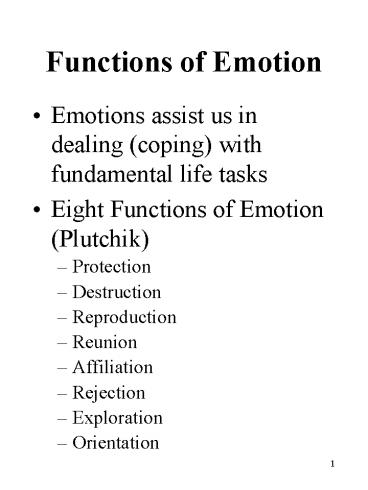Functions of Emotion - PowerPoint PPT Presentation
1 / 16
Title:
Functions of Emotion
Description:
changes in glandular activity in the facial skin. 8. Can we voluntarily control our emotions? ... facial expression. rate of neural firing. behavioral consequences ... – PowerPoint PPT presentation
Number of Views:2052
Avg rating:3.0/5.0
Title: Functions of Emotion
1
Functions of Emotion
- Emotions assist us in dealing (coping) with
fundamental life tasks - Eight Functions of Emotion (Plutchik)
- Protection
- Destruction
- Reproduction
- Reunion
- Affiliation
- Rejection
- Exploration
- Orientation
2
Social Functions of Emotion
- Communicating our feelings to others
- Regulating how others respond to us
- Inviting facilitating social interaction
- Creating, maintaining, dissolving interpersonal
relationships
3
Five Biological Aspects of Emotion
- Autonomic Nervous System
- arousal regulation of the heart, lungs,
muscles - Endocrine System
- activation of glands, hormones, organs
- Neural Brain Circuits
- limbic brain structures such as the hypothalamus
- Rate of Neural Firing
- how quickly information is processed
- Facial Feedback
- patterns of facial musculature
4
James-Lange Theory
- Two assumptions
- the body reacts discriminately to different
emotion-eliciting stimuli - non-emotional stimuli do not elicit bodily
change - Cannons Criticism
- bodily changes augment rather than cause emotion
5
The Contemporary Perspective
- A few emotions have distinctive patterns of
physiological activity, but most do not. - Distinctive patterns of ANS activity associated
with anger, fear, disgust, sadness - Distinctive patterns of CNS activity associated
with joy, fear, rage, anxiety
6
Neural Activation
- different emotions are activated by different
rates of neural firing, and whether the rates are
increasing, decreasing, or remaining constant
(Tomkins) - the rate is largely dependent upon environmental
events
7
Facial Feedback Hypothesis
- Emotions arise from
- movements of the facial musculature
- changes in facial temperature
- changes in glandular activity in the facial skin
8
Can we voluntarily control our emotions?
- Biological interpretation
- emotions are governed by subcortical structures
pathways, so they are largely beyond our control - Cognitive interpretation
- emotions are governed by thoughts, beliefs, and
ways of thinking, so they can be controlled to a
great extent - An integrative interpretation
- the onset of emotion is difficult to control, but
we can control the rise, fall, and intensity of
our emotions
9
Differential Emotions Theory (Izard)
- Motivation arises from ten discrete emotions,
each of which is defined in terms of its - unique subjective feeling
- facial expression
- rate of neural firing
- behavioral consequences
- Emotions are motivational systems that prepare us
to act in adaptive ways
10
What about other emotions?
- Emotion families exist, so many emotions are
simply derivatives or combinations of basic
emotions - Many emotion terms really describe moods,
attitudes, personality traits, and disorders.
11
Cognitive Theories of Emotion
- Emotions only occur with an antecedent appraisal
of a stimulus event - The appraisal, not the stimulus event, causes
emotion
12
Appraisal of Emotion (Arnold)
- Emotion results from the interaction of
cognition, neurophysiology, and arousal - Emotion has both directional force (from the
tendency to approach or avoid) and energy (from
physiological changes)
13
Primary Secondary Appraisal (Lazarus)
- Primary Appraisal - automatic evaluation of the
relevance of an event - Secondary Appraisal - assessment of how to cope
with emotion-generating event
14
Emotion Knowledge
- Experience leads to an understanding of different
variations of emotions - The number of emotions that we can distinguish is
dependent upon this experience - Knowledge also informs our primary secondary
appraisals
15
Emotion and Attribution
- Primary Secondary appraisals are made following
outcomes (Weiner) - Primary
- was outcome good or bad?
- leads to basic emotion of happiness or sadness.
- Secondary
- what is outcome attributed to?
- differentiates emotional reaction into more
specific secondary emotions
16
Social Cultural Construction of Emotion
- Most emotions originate in social interaction
- Appropriate or expected emotions are defined by
social situations - Emotional Contagion
- Emotional Socialization
- Managing Emotions































![[PDF] Molecules of Emotion: Why You Feel the Way You Feel Ipad PowerPoint PPT Presentation](https://s3.amazonaws.com/images.powershow.com/10081905.th0.jpg?_=20240719032)